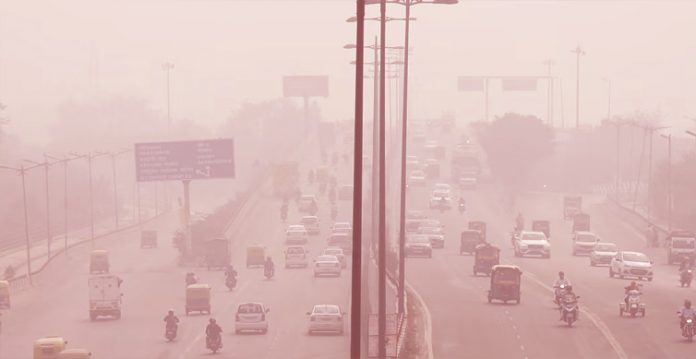New Delhi: The levels of air pollution throughout Diwali this year were discovered to be a lot higher when compared to the previous year while a significant dip was seen in noise pollution level, the Central Pollution Control Board (CPCB) revealed on Sunday.
The CPCB stated in a special report that nearly all pollutants reported higher values on the day of Diwali and pre-Diwali day this year as compared with 2019
The report read, “It is observed that if compared with 2019 pre-Deepawali day (21.10.2019) concentrations of NO2, PM10 and PM2.5 were found to be much higher on the pre-Deepawali day (on 09.11.2020) at all the monitored locations, while SO2 concentrations were at a similar level. On Deepawali day (14.11.2020), almost all the pollutants reported higher values as compared to 2019 Diwali day.”
However, the report attributed its result to a high portion of stubble burning and meteorological conditions and the perpetual issue of deteriorated air quality during November in Delhi-NCR, not on account of firecracker bursting. Though Pitampura recorded a rise in PM and SO2 demonstrating the effect of firecracker bursting on Deepawali day, it included.
The report uncovered that the contribution of stubble burning in Delhi’s PM2.5 concentration was 32 per cent on the day of Diwali this year as compared to 19 per cent last year. Therefore, it may be concluded that elevated PM2.5 concentrations in 2020 in comparison to the previous year had heightened contribution of stubble burning and the same is also reflected in elevated levels of CO and NO2.
The CPCB saw that the hourly average concentration of PM2.5 began rising from 11 p.m. on November 14, it arrived at the top in most of the stations at around 1 a.m. also, proceeded at higher levels till 5 a.m. The city-level average accounted for PM10 and PM2.5 concentrations on Deepawali day were 645 ug/m3 and 483 ug/m3 individually.
The report included, “Most of the parameters including PM2.5 monitored by stations set-up at IHBAS (Dilshad Garden), DMS (Shadipur) and NSIT (Dwarka) were found more on both pre-Deepawali and Deepawali days compared to 2019.”
In the interim, the central agency saw a significant drop in the noise pollution level this year in comparison with 2019.
The manual checking of six areas before Diwali uncovered that the noise level was found to have declined at Lajpat Nagar, Mayur Vihar Phase-II, and Janakpuri, in comparison with the last year. In any case, the highest level was recorded at Kamla Nagar this year on pre-Deepawali day, the report said.
In the interim, real-time checking of ten stations indicated that day time noise levels have declined in 2020 when compared with the pre-Deepawali day of 2019 at seven areas. Just NSIT Dwarka, R.K. Puram and ITO stations have recorded a slight increase in day time noise. The evening time noise discovered to have increased at Anand Vihar and ITO, the report stated.
CPCB directed ambient air quality and noise level checking on the select pre-Deepawali day (09.11.2020) and on Deepawali day (14.11.2020) in Delhi like earlier years. Ambient Air Quality was checked at 40 areas (3 manual stations and 37 real-time stations). The ambient Noise level was observed at 16 areas (06 manual and 10 real-time noise checking stations). Three continuous air quality stations (worked by CPCB, NABL accredited) have been utilized for comparison with the previous five years’ information.
CPCB directed ambient air quality and noise level observing on pre-Deepawali and Deepawali day in Delhi. The air quality was checked at 40 areas with 3 manual stations and 37 real-time stations. In the interim, the ambient noise level was checked at 16 areas including 6 manual and 10 real-time noise observing stations.
The air quality dropped to severe at a few spots over the national capital on Saturday late evening owing to a mix of stubble burning and firecrackers burst during the Diwali festivities infringing upon a ban on the same.
The Air Quality Index (AQI) for PM 2.5 pollutant remained at 481 in Anand Vihar, 444 in IGI Airport region, 414 in Lodhi Road region, and 457 in ITO, every one of the four in the ‘severe’ category, at 11 pm on Saturday, as per the Delhi Pollution Control Committee (DPCC) information.
A thick cover of fog was seen at many spots over the national capital as the Diwali festivities reached to an end late Saturday night.
withIANSinputs


